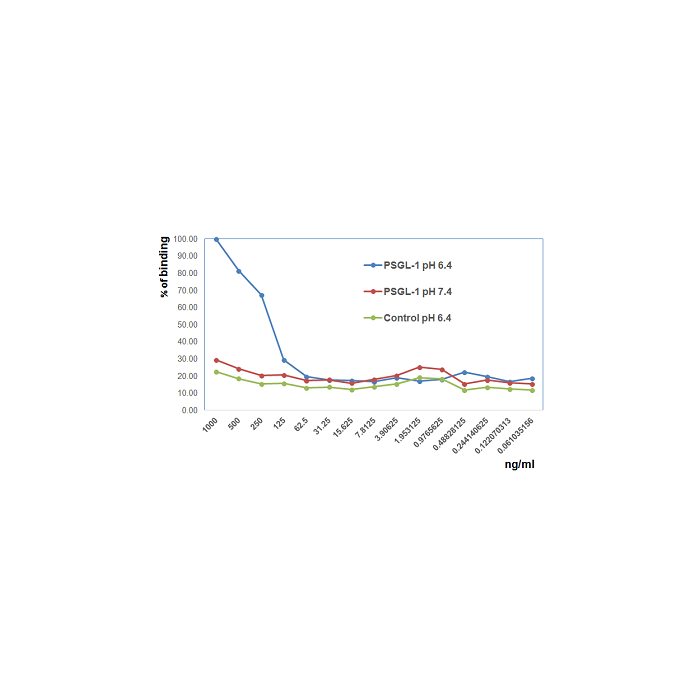Cookie Policy: This site uses cookies to improve your experience. You can find out more about our use of cookies in our Privacy Policy. By continuing to browse this site you agree to our use of cookies.
AdipoGen Life Sciences
PSGL-1 (human):Fc (human) (rec.)

| Product Details | |
|---|---|
| Synonyms | P-selectin Glycoprotein Ligand 1; Selectin P Ligand; CD162; SELPLG |
| Product Type | Protein |
| Properties | |
| Source/Host | HEK 293 cells |
| Sequence |
The extracellular domain of human PSGL-1 (aa 42-305) is fused at the C-terminus to the Fc portion of human IgG1. |
| Crossreactivity | Human |
| Biological Activity |
Binds to the human protein VISTA at acidic pH 6.4. |
| MW | ~95-100kDa (SDS-PAGE) |
| Purity | ≥95% (SDS-PAGE) |
| Endotoxin Content | <0.01EU/μg purified protein (LAL test). |
| Concentration | 1mg/ml after reconstitution. |
| Reconstitution |
50µg size: Reconstitute with 50µl sterile water. 500µg size: Reconstitute with 500µl sterile water. |
| Accession Number | Q14242 |
| Formulation | Lyophilized. Contains PBS. |
| Protein Negative Control | |
| Other Product Data |
UniProt link Q14242: PSGL-1 (human) |
| Shipping and Handling | |
| Shipping | BLUE ICE |
| Short Term Storage | +4°C |
| Long Term Storage | -20°C |
| Handling Advice |
After reconstitution, prepare aliquots and store at -20°C. Avoid freeze/thaw cycles. Centrifuge lyophilized vial before opening and reconstitution. PBS containing at least 0.1% BSA should be used for further dilutions. |
| Use/Stability |
Stable for at least 6 months after receipt when stored at -20°C. Working aliquots are stable for up to 3 months when stored at -20°C. |
| Documents | |
| MSDS |
 Download PDF Download PDF |
| Product Specification Sheet | |
| Datasheet |
 Download PDF Download PDF |
P-selectin glycoprotein ligand-1 (PSGL-1) is a 120kda transmembrane homodimer protein that is primarily expressed on lymphoid and myeloid cells, including platelets. PSGL-1 was first identified to regulate the rolling/tethering of neutrophils on activated endothelium through P-selectin binding. PSGL-1 binds P-, E- and L- selectin through the N-terminus of the extracellular domain upon special glycosylation (sialyl Lewis x). PSGL-1 functions in regulating the migration of macrophages/monocytes, plasma B cells, dendritic cells and T cells by selectin engagement. PSGL-1 also regulates localization of macrophages, dendritic cells and B cells in the lamina propria at steady state. Although PSGL-1 is expressed on resting T cells, selectin binding capacity is only acquired during the proliferation/differentiation of effector T cells.
In addition to its migratory properties, the adhesion protein PSGL-1 also functions in a selectin-independent manner as a negative regulator of T cell responses in contexts of chronic viral infection, cancer and some autoimmune diseases. For this immune checkpoint function, it has recently been reported that PSGL-1 binds the negative immune checkpoint regulator VISTA (V-domain immunoglobulin suppressor of T cell activation). PSGL-1 expressed on leukocytes binds to multimeric VISTA at acidic pH, but not at the physiological pH 7. This acidic influence of the binding is due to multiple histidine residues protonation located in the VISTA extracellular domain. VISTA - PSGL-1 interaction shows that immune response can be regulated by acidic environments found in tumors. Identification of PSGL-1 - VISTA signaling pathways in T cells could lead to new therapeutic targets that increase immune function, such as in chronic viral infections or in cancer, or attenuate immune function such as in autoimmunity.
- VISTA is an acidic pH-selective ligand for PSGL-1: R.J. Johnston, et al.; Nature 574, 565 (2019)






![B7-H5 [VISTA] (human) (rec.) (His)](https://update.adipogen.com/media/catalog/product/placeholder/default/adipogen_logo_bw_3.png)
![VISTA [B7-H5] (mouse):Fc (human) (rec.)](https://update.adipogen.com/media/catalog/product/cache/9c281c7ec96bf9060309dac73f492a03/a/g/ag-40b-0164_biological_activity-250.png)